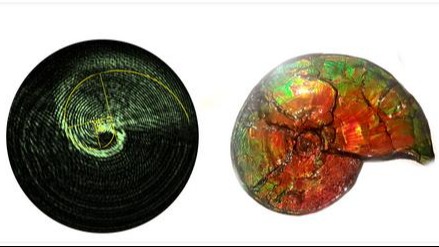A New Form of Light Spirals Just Like Nautilus Shells and Sunflower Seeds
Posted on Categories Discover Magazine

Patterns exist all around the world, creating unforgettable designs exhibited by organisms and acts of nature. Some of these designs even share surprising connections, like a spiral shape seen in both marine mollusks and a newly discovered structure of light that moves like a vortex. A recent study found that the movement of this light vortex — called an optical rotatum — occurs in a way that is very similar to the Fibonacci sequence, the mathematical concept behind many of nature’s most iconic designs.
The study, published in Science Advances, shows an unprecedented perspective on how light demonstrates parallels with nature. With its unorthodox movements, the optical rotatum could open new possibilities for matter manipulation.
New Behavior of Light
The shape of a vortex emerges in familiar phenomena such as tornadoes and whirlpools, and it’s even responsible for the formation of galaxies. Beams of light can be twisted to form optical vortices that take a similar shape; optical vortices are often used for wireless transmission of data, the creation of holograms, and numerous other applications.
The new study describes the optical rotatum as a distinct type of optical vortex beam that not only twists as it moves, but also expresses the unique spiral shape seen so often in nature. The rotatum part of its name explains the gradual change of the light’s torque; similarly, in Newtonian physics, the term refers to the change in torque on an object over time.
“This is a new behavior of light consisting of an optical vortex that propagates through space and changes in unusual ways,” said Federico Capasso, a Harvard physicist whose lab made the discovery, in a statement. “It is potentially useful for manipulating small matter.”
Read More: Are These 10 Natural Occurrences Examples of the Fibonacci Sequence?
Growing With the Golden Ratio
The researchers involved with the study were surprised to find that the optical rotatum grew in a pattern that is close to the Fibonacci sequence, a series of numbers where each number is the sum of the two previous numbers (it starts as 0, 1, 1, 2, 3, 5, 8, 13, 21). The sequence is closely associated with the golden ratio, a mathematical relationship that is closely linked with compositions across nature and art.
The optical rotatum grows in a spiral shape that is also present in the shell of a nautilus (a type of mollusk), sunflower seeds, and branches of trees.
“That was one of the unexpected highlights of this research,” said first author Ahmed Dorrah, a physicist at Eindhoven University of Technology who was previously a research associate at Capasso’s lab. “Hopefully we can inspire others who are specialists in applied mathematics to further study these light patterns and gain unique insights into their universal signature.”
Prior to this discovery, the research team had focused on working with a metasurface (an artificial sheet that has light-bending nanostructures) to create light beams that could convert into other structures that change as they move.
An Easier Way to Control Light
The optical rotatum extends the utility of light by providing another option for manipulating matter. For example, the light could give researchers access to a precise optical tweezer that could handle very small particles.
The researchers also note the particular method used to create the optical rotatum, through a single liquid crystal display and a low-intensity light beam. Different than other demonstrations involving high-intensity lasers and bulkier setups, this simpler method could prove to be beneficial for future research on changing the torque of light.
Read More: Will Humans Ever Go Faster Than Light?
Article Sources
Our writers at Discovermagazine.com use peer-reviewed studies and high-quality sources for our articles, and our editors review for scientific accuracy and editorial standards. Review the sources used below for this article:
Jack Knudson is an assistant editor at Discover with a strong interest in environmental science and history. Before joining Discover in 2023, he studied journalism at the Scripps College of Communication at Ohio University and previously interned at Recycling Today magazine.